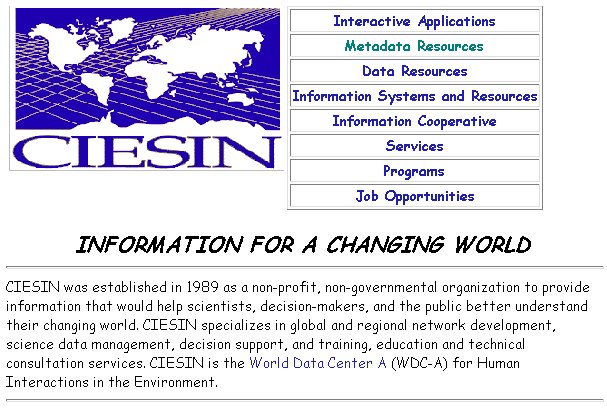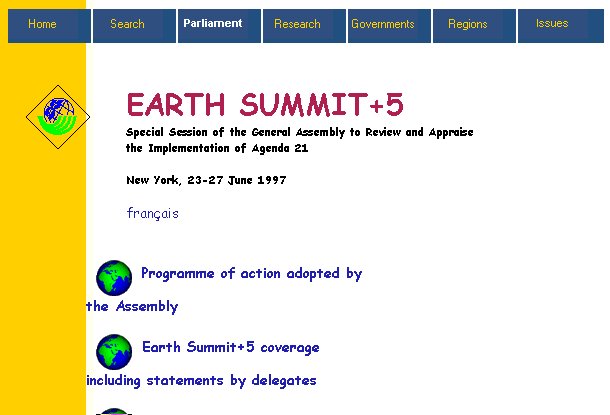Planet SOSIG
Browsing the Environment Section
SOSIG has chosen to use the Universal Decimal Classification (UDC) scheme to produce the browsable sub-sections for its database. The sections from this scheme that I selected from the general class of Environmental Sciences [1] were: Social and socio-economic aspects of human impact on the environment (social ecology); Adverse effects of human activity on the environment; and Protection of the environment, Management of environmental quality. (For convenience these have been shortened to Social ecology, Adverse effects of human activity, and Protection of the environment respectively).
As with all classification schemes, these divisions have some short-comings in terms of their precision and thought will need to be given to further subdivisions in the future as the database continues to expand. In the meantime, users will find resources on sustainability and renewable energy under Social ecology; resources on depletion of natural resources, pollution and environmental destruction under Adverse effects of human activity; and control of pollution, monitoring, recycling, waste disposal, and environmental law under Protection of the environment. Clearly there are many resources which overlap these sections and which will be found featured in more than one.

Figure 1. ‘Environmental Sciences and Issues’ section of SOSIG
Apart from these broad subject categories, however, the large number of environmental sites available on the Internet do break down naturally into a number of different types of resource.
Non-Governmental Organizations
Some of the most useful resources are those produced by the major non-governmental organizations. The United Nations Environment Programme (UNEP) has its own Web site [2] which uses the global medium of the Internet to further the organization’s remit of promoting global approaches to caring for the environment. The World Bank’s development section [3] provides environmental indicators and its own energy-environment strategy. CIESIN (Consortium for International Earth Science Information Network) [4] is another non-governmental organization which is a very useful source of information aimed at the public, decision-makers and scientists. The site provides access to many databases, ‘Thematic Guides’ to issues concerning environmental change, and the full text of scholarly papers, reports, working papers and newsletters.

Figure 2. CIESIN homepage
And there is also CEDAR (the Central European Environmental Data Request Facility) [5], an organization which was set up to provide computing and Internetwork facilities to support international data exchange with the Central and Eastern European environmental community.
Other sources of environmental data come from independent environmental organizations/think tanks such as the Ecological Society of America [6], although such sources often require payment for their reports.
Government Data Sources
Governments are now becoming useful providers of information over the World Wide Web including data about the environment and the policies they are enacting to protect it. The European Union is well represented with the European Environment Agency [7], established to provide high-quality information for the European Union, and Directorate-General XI of the European Commission: Environment, Nuclear Safety and Civil Protection [8]. The Canadian Government provide an excellent site called The Green Lane [9], and, as usual, the US Government offer large amounts of data via the United States Environmental Protection Agency [10].
In the UK, there is the Environment Agency of England and Wales [11] and the Natural Environment Research Council [12], one of the seven UK Research councils and which is the leading body in the UK for research, survey, monitoring and training in the environmental sciences.
The Environment A-Z
As well as the general approaches of the above sites, as might be expected there are many Internet resources covering more specific subject areas, from composting (Humusphere [13]) to endangered species (Species Under Threat [14], giving details from the World Conservation Union’s `Red Lists’ of endangered plants and animals). Or, were you aware that 1998 was declared the International Year of the Ocean by the United Nations? Have a look at the International Year of the Ocean Homepage [15].
Ozone depletion is a topic of particular concern and the Stratospheric Ozone and Human Health World Wide Web Site [16] provides a multidisciplinary data resource for health officials, decision makers, government officials, researchers, and the general public. This resource is produced through a collaboration between NASA and the Socioeconomic Data and Applications Center (SEDAC), part of CIESIN (mentioned above [4]).
Information on pollution in its many forms can be found in many resources such as the National Air Quality and Emissions Trends Report, 1996 [17], Russian Northern Fleet: Sources of Radioactive Contamination [18], or Air Quality Issues [19] (an online newsletter from the Atmospheric Research and Information Centre, Manchester Metropolitan University).
Environmental legislation and treaties
ENTRI (Environmental Treaties and Resource Indicators) is an online search service for finding information about environmental treaties [20] and provides the complete texts of more than 169 environmental agreements (and is also provided by CIESIN!), and The Environmental Law Information Center [21] has information regarding US environmental law.
Some of the more recent international conventions now have their own Web sites, notably Earth Summit +5 [22] which reports from a UN General Assembly meeting in special session on progress on “Agenda 21”, adopted at the Earth Summit, Rio de Janeiro, in 1992; as well as the Kyoto site [23] (see [24] for the full text of the Kyoto Protocol in pdf format and [25] for a gopher version of Agenda 21).

Figure 3. Earth Summit +5 homepage
Other sources of environmental information on the Internet come in the form of journals and newsletters such as The Earth Times [26], Electronic Green Journal [27], Ethics and the Environment [28] (abstracts only), and Global Climate Change News [29], a monthly newsletter from the Atmospheric Research and Information Centre (ARIC), Manchester Metropolitan University. There are also the usual large numbers of mailing lists which can keep you up to date on developments (to find these you can use the extended search options of SOSIG and look for ‘MAIL ARCHIVE’ under ‘Type of resource’, to filter your search).
This article has provided an overview of some of the resources catalogued on the SOSIG database. We hope we have picked out at least some of the best of the crop of environmental data of use to researchers in the social sciences. Perhaps one of the largest categories of environmental site available on the Web comprises those aimed at a lay audience and which are usually of little interest to researchers. These can easily form the majority of hits returned from a Web search engine. This is one category of resource we avoid on SOSIG!
Of course, there will be other sources of useful information of which we are unaware. SOSIG provides a page which enables its users to submit the URLs of their favorite sites [30]. Please feel free to submit any such sites you haven’t found in SOSIG which you feel your colleagues would benefit from knowing about.
References
[1] The Environmental Sciences and Issues section can be found at:
URL: <http://www.sosig.ac.uk:80/roads/subject-listing/World/envsci.html>
[2] United Nations Environment Programme (UNEP):
URL: <http://www.unep.org/>
[3] World Bank: Topics in Development:
URL: <http://www.worldbank.org/html/extdr/thematic.htm>
[4] CIESIN:
URL: <http://www.ciesin.org/>
[5] CEDAR:
URL: <http://www.cedar.univie.ac.at/>
[6] Ecological Society of America:
URL: <http://esa.sdsc.edu/esa.htm>
[7] European Environment Agency:
URL: <http://www.eea.dk/>
[8] Directorate-General XI of the European Commission:
URL: <http://www.europa.eu.int/en/comm/dg11/dg11home.html>
[9] The Green Lane:
URL: <http://www.ec.gc.ca/envhome.html>
[10] United States Environmental Protection Agency:
URL: <http://www.epa.gov/>
[11] Environment Agency of England and Wales:
URL: <http://www.environment-agency.gov.uk/>
[12] Natural Environment Research Council:
URL: <http://www.nerc.ac.uk/>
[13] Humusphere:
URL: <http://www.composter.com/>
[14] Species Under Threat:
URL: <http://www.wcmc.org.uk/species/data/species_sheets/>
[15] International Year of the Ocean Homepage:
URL: <http://ioc.unesco.org/iyo/>
[16] Stratospheric Ozone and Human Health World Wide Web Site:
URL: <http://sedac.ciesin.org/ozone/>
[17] National Air Quality and Emissions Trends Report, 1996:
URL: <http://www.epa.gov/oar/aqtrnd96/>
[18] Russian Northern Fleet: Sources of Radioactive Contamination:
URL: <http://www.bellona.no/e/russia/nfl>
[19] Air Quality Issues:
URL: <http://www.doc.mmu.ac.uk/aric/newaric.html>
[20] ENTRI:
URL: <http://sedac.ciesin.org/entri/>
[21] Environmental Law Information Center:
URL: <http://www.webcom.com/~staber/welcome.html>
[22] Earth Summit +5:
URL: <http://www.un.org/esa/earthsummit/>
[23] Official Site of the Third Conference of the Parties to the UNFCCC, Kyoto, December 1-10, 1997:
URL: <http://www.cop3.de/>
[24] Kyoto Protocol to the United Nations Framework Convention on Climate Change:
URL: <http://www.cop3.de/fccc/docs/cop3/l07a01.pdf>
[25] Agenda 21:
URL: <gopher://gopher.un.org:70/11/conf/unced/English>
[26] The Earth Times:
URL: <http://www.earthtimes.org/>
[27] Electronic Green Journal:
URL: <http://www.lib.uidaho.edu:70/docs/egj.html>
[28] Ethics and the Environment:
URL: <http://www.phil.uga.edu/eande/>
[29] Global Climate Change News:
URL: <http://www.doc.mmu.ac.uk/aric/gcc/newgccip.html>
[30] Submit a New Resource to SOSIG:
URL: <http://sosig.ac.uk/sosig/cgi/newurl.pl>
Author details
Phil CrossResearch Officer
ILRT (Institute for Learning and Research Technology)
Email: phil.cross@bristol.ac.uk
